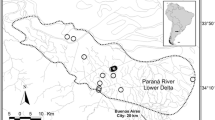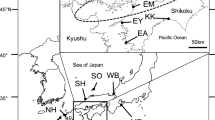Abstract
In this study, we used genetic-based approaches to estimate population size and structure of Eurasian otter along the Drava River in Hungary, and compared these results to traditional survey-based methods. The relative spraint density of otter was estimated based on the number of fresh (Df) and total number (Dt) of spraints collected on standard routes over a 2-year period. Nine microsatellite loci were screened, generating 17 individual otter genotypes composed of 45 different alleles. The expected heterozygosity ranged from 0.53 to 0.89 and observed heterozygosity from 0.25 to 0.92. The mean density (Dg) estimated over six different sites was 0.17 individuals per km of shoreline. A close correlation was found between the number of genotypes and spraint counts along a standard route (fresh spraints: rP = 0.85, P<0.01; total spraints rP = 0.76, P<0.05). All genotypes found within the 50km-long study area were closely related (Dm ranged between 0.08 and 0.21).
Zusammenfassung
In dieser Untersuchung verwendeten wir genetische Methoden, um die Populationsgröße und -struktur des eurasischen Fischotters am Fluß Drau in Ungarn abzuschätzen. Die Ergebnisse wurden mit jenen aus traditionellen Untersuchungen verglichen. Die relative Losungsdichte wurde berechnet auf Grund der Anzahl von frischem (Df) und der Anzahl von gesamter Losung (Dt), die entlang von Standardrouten in einem zweijährigen Zeitraum gesammelt wurden. Neun Mikrosatelliten wurden verwendet, die insgesamt 45 Allele aufwiesen. Dadurch konnten 17 individuelle Genotypen unterschieden werden. Die erwartete Heterozygotie reichte von 0.53 bis 0.89, und die beobachtete Heterozygotie reichte von 0.25 bis 0.92. Die mittlere Dichte (Dg) über sechs Stellen war 0.17 Individuen/km. Es gab eine signifikante Korrelation zwischen der Anzahl von Genotypen und der Anzahl gefundener Losung entlang von Standardrouten (frische Losung: rP = 0.85, P<0.01; gesamte Losung rP = 0.76, P<0.05). Alle Genotypen, die innerhalb des 50 km langen Untersuchungsgebietes gefunden wurden, waren nah mit einander verwandt (Dm reichte von 0.08 bis 0.21).
Similar content being viewed by others
References
Arrendal, J., Walker, C.W., Sundqvist, A.K., Hellborg, L., Vila, C., 2004. Genetic evaluation of an otter translocation program. Conserv. Genet. 5, 79–88.
Conroy, J.W.H., Chanin, P.R.F., 2002. The status of the Eurasian otter (Lutra lutra). IUCN OSG Bull. 19A, 24–48.
Conroy, J.W.H., French, D.D., 1987. The use of spraints to monitor populations of otters (Lutra lutra L). Symp. Zool. Soc. London 58, 247–262.
Coxon, K., Chanin, P., Dallas, J., Sykes, T., 1999. The use of DNA fingerprinting to study the population dinamics of otters (Lutra lutra) in Southern Britain: a feasibility study. Research and Development Technical Report W202.
Dallas, J.F., Piertney, S.B., 1998. Microsatellite primers for the Eurasian otter. Mol. Ecol. 7, 1248–1251.
Dallas, J.F., Bacon, P.J., Carss, D.N., Conroy, J.W.H., Green, R., Jefferies, D.J., Kruuk, H., Marshall, F., Piertney, S.B., Racey, P.A., 1999. Genetic diversity in the Eurasian otter, Lutra lutra, in Scotland. Evidence from microsatellite polymorphism. Biol. J. Linn. Soc. 68, 73–86.
Dallas, J.F., Carss, D.N., Marshall, F., Koepfli, K.P., Kruuk, H., Bacon, P.J., Piertney, S.B., 2000. Sex identification of the Eurasian otter Lutra lutra by PCR typing of spraints. Conserv. Genet. 1, 181–183.
Dallas, J.F., Marshall, F., Piertney, S.B., Bacon, P.J., Racey, P.A., 2002. Spatially restricted gene flow and reduced microsatellite polymorphism in the Eurasian otter Lutra lutra in Britain. Conserv. Genet. 3, 15–29.
Dallas, J.F., Coxon, K.E., Sykes, T., Chanin, P.R.F., Marshall, F., Carss, D.N., Bacon, P.J., Piertney, S.B., Racey, P.A., 2003. Similar estimates of population genetic composition and sex ratio derived from carcasses and faeces of European otter Lutra lutra. Mol. Ecol. 12, 275–282.
Dulfer, R., Foerster, K, Roche, K, 1998. Habitat use, home range and behaviour. In: Dulfer, R., Roche, K. (Eds.), First Phase Report of the Trebon Otter Project. Scientific Background and Recommendations for Conservation and Management Planning, vol. 93. Council of Europe Publishing, Strasbourg, pp. 31–46.
Erlinge, S., 1968. Territoriality of the otter Lutra lutra L. Oikos 19, 81–98.
Goudet, J., 1995. FSTAT (ver. 1.2): a computer program to calculate F-statistics. J. Hered. 86, 485–486.
Hájková, P., Pertoldi, C., Zemanová, B., Roche, K., Hájek, B., Bryja, J., Zima, J., 2007. Genetic structure and evidence for recent population decline in Eurasian otter populations in the Czech and Slovak Republics: implications for conservation. J. Zool. (London) 272, 1–9.
Hung, C.M., Li, S.H., Lee, L.L., 2004. Faecal DNA typing to determine the abundance and spatial organization of otters (Lutra lutra) along two streams in Kinmen. Anim. Conserv. 7, 301–311.
Jefferies, D.J., 1986. The value of otter Lutra lutra surveying using spraints: an analysis of its successes and problems in Britain. Otters, J. Otter Trust 1, 25–32.
Jenkins, D., 1980. Ecology of otters in northern Scotland: I. otter (Lutra lutra) breeding and dispersion in mid-Deeside, Aberdeenshire, in 1974-79. J. Anim. Ecol. 49, 713–735.
Juhász, M., Dénes, A., 2005. Biomonitoring of alluvial willow forests. Nat. Somogy. 7, 11–18.
Kalz, B., Jewgenow, K., Fickel, J., 2006. Structure of an otter (Lutra lutra) population in Germany - results of DNA and hormone analyses from faecal samples. Mamm. Biol. 71, 321–335.
Kohn, M.H., Wayne, R.K., 1997. Facts from feces revisited. Tree 12, 223–227.
Kruuk, H., Conroy, J.W.H., 1987. Surveying otter Lutra lutra populations: a discussion of problems with spraints. Biol. Conserv. 41, 179–183.
Kruuk, H., Conroy, J.W.H., Glimmerween, U., Ouwerkerk, E.J., 1986. The use of spraints to survey populations of otters Lutra lutra. Biol. Conserv. 35, 187–194.
Kruuk, H., Moorhouse, A., Conroy, J.W.H., Durbin, L., Frear, S., 1989. An estimate of numbers and habitat preference of otters Lutra lutra in Shetland, UK. Biol. Conserv. 49, 241–254.
Kruuk, H., Conroy, J.W.H., Moorhouse, A., 1991. Recruitment to a population of otters (Lutra lutra) in Shetland, in relation to fish abundance. J. Appl. Ecol. 28, 95–101.
Kruuk, H., Carss, D.N., Conroy, J.W.H., Durbin, L., 1993. Otter (Lutra lutra) numbers and fish productivity in rivers in N.E. Scotland. Symp. Zool. Soc. London 65, 171–191.
Langella, O., 1999. POPULATIONS 1.2.28 software (http://www.prs-gif.fr.
Lanszki, J., 2005. Otter monitoring between 2000 and 2004 in the Drava region (Hungary). Nat. Somogy. 7, 169–178.
Lanszki, J., Sallai, Z., 2006. Comparison of the feeding habits of Eurasian otters on a fast flowing river and its backwater habitats. Mamm. Biol. 71, 336–346.
Mason, C.F., Macdonald, S.M., 1986. Otters: Ecology and Conservation. Cambridge University Press, Camridge.
Mason, C.F., Macdonald, S.M., 1987. The use of spraints for surveying otter Lutra lutra populations: an evaluation. Biol. Conserv. 41, 167–177.
Page, R.D.M., 1996. TREEVIEW: an application to display phylogenetic trees on personal computers. Comput. Appl. Biosci. 12, 357–358.
Pertoldi, C., Hansen, M.H., Loeschcke, V., Madsen, A.B., Jacobsen, L., Baagoe, H, 2001. Genetic consequences of population decline in the European otter (Lutra lutra): an assessment of microsatellite DNA variation in Danish otters from 1883 to 1993. Proc. R. Soc. London, Ser. B. 268, 1775–1781.
Prigioni, C., Remonti, L., Balestrieri, A., Sgrosso, S., Priore, G, Misin, C., Viapiana, M., Spada, S., Anania, R., 2005. Distribution and sprainting activity of the otter (Lutra lutra) in the Pollino National Park (southern Italy). Ethol. Ecol. Evol. 17, 171–180.
Ramekers, J., Hummel, S., Hermann, B., 1997. How many cycles does a PCR need? Determination of cycle numbers depending of the number of targets and the reaction efficiency factor. Naturwissenschaften 84, 259–262.
Randi, E., Davoli, F., Pierpaoli, M., Pertoldi, C., Madsen, A.B., Loeschcke, V., 2003. Genetic structure in otter (Lutra lutra) populations in Europe: implications for conservation. Anim. Conserv. 6, 93–100.
Raymond, M., Rousset, F., 1995. GENEPOP (version 1.2): population genetics software for exact tests and ecumenicism. J. Hered. 86, 248–249.
Reuther, C., Dolch, D., Green, R., Jahrl, J., Jefferies, D., Krekemeyer, A., Kucerova, M., Madsen, A.B., Romanowski, J., Roche, K., Ruiz- Olmo, J., Teubner, J., Trindade, A., 2000. Surveying and monitoring distribution and population trends of the Eurasian otter (Lutra lutra). Habitat 12, Hankensbüttel, Germany.
Ruiz-Olmo, J., Gosálbez, J., 1997. Observations on the sprainting behaviour of the otter Lutra lutra in the NE Spain. Acta Theriol. 42, 259–270.
Ruiz-Olmo, J., Lopez-Martin, J.M., Palazon, S., 2001a. The influence of fish abundance on the otter (Lutra lutra) populations in Iberian Mediterranean habitats. J. Zool. (London) 254, 325–336.
Ruiz-Olmo, J., Saavedra, D., Jiménez, J., 2001b. Testing the surveys and visual and track censuses of European otter (Lutra lutra). J. Zool. (London) 253, 359–369.
Ruiz-Olmo, J., Olmo-Vidal, J.M., Manas, S., Batet, A., 2002. The influence of resource seasonality on the breeding patterns of the Eurasian otter (Lutra lutra) in Mediterranean habitats. Can. J. Zool. 80, 2178–2189.
Sidorovich, V.E., Jedrzejewska, B., Jedrzejewski, W., 1996. Winter distribution and abundance of predatory mustelids and beavers in the river valleys of Bialowieza Primeval Forest. Acta Theriol. 41, 155–170.
Sidorovich, V.E., Pikulik, M.M., 2002. Factors allowing high density of otters in Eastern Europe. IUCN OSG Bull. 19A, 326–333.
SPSS 10 for Windows, 1999. SPSS Inc., Chicago.
Taberlet, P., Luikart, G., 1999. Non-invasive genetic sampling and individual identification. Biol. J. Linn. Soc. 68, 41–55.
Taberlet, P., Griffin, S., Goossens, B., Questiau, S., Manceau, V., Escaravage, N, Waits, L.P., Bouvet, J., 1996. Reliable genotyping of samples with a very low DNA quantities using PCR. Nucleid Acids Res. 24, 3189–3194.
Taberlet, P., Waits, L.P., Luikart, G., 1999. Noninvasive genetic sampling: look before you leap. Trends Ecol. Evol. 14, 323–327.
Takezaki, N., Nei, M., 1996. Genetic distances and reconstruction of Phylogenetic trees from Microsatellite DNA. Genetics 144, 189–399.
Valière, N., 2002. Gimlet: a computer program for analysing genetic individual identification data. Mol. Ecol. Notes 2, 377–379.
White, P.C.L., McClean, C.J., Woodroffe, GL., 2003. Factors affecting the success of an otter (Lutra lutra) reinforcement programme, as identified by post-translocation monitoring. Biol. Conserv. 112, 363–371.
Wilson, G. J., Delahay, R.J., 2001. A review of methods to estimate the abundance of terrestrial carnivores using field signs and observations. Wildl. Res. 28, 151–164.
Závodszky, S., 2005. Hydroelectricity or national park? Nat. Somogy. 7, 5–9.
Author information
Authors and Affiliations
Corresponding author
Rights and permissions
About this article
Cite this article
Lanszki, J., Hidas, A., Szentes, K. et al. Relative spraint density and genetic structure of otter (Lutra lutra) along the Drava River in Hungary. Mamm Biol 73, 40–47 (2008). https://doi.org/10.1016/j.mambio.2007.08.005
Received:
Accepted:
Published:
Issue Date:
DOI: https://doi.org/10.1016/j.mambio.2007.08.005




